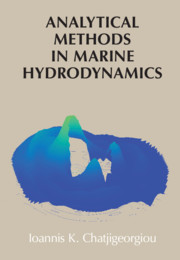Book contents
- Analytical Methods in Marine Hydrodynamics
- Dedication
- Analytical Methods in Marine Hydrodynamics
- Copyright page
- Contents
- Foreword
- Preface
- Note on Symbols and Notations
- 1 Description of the Flow
- 2 Linear Hydrodynamics of Circular Cylinders
- 3 Higher-Order Phenomena for Circular Cylinders
- 4 Hydrodynamics of Elliptical Cylinders
- 5 Hydrodynamics of Spheres and Spheroids
- 6 Hydrodynamics of Ellipsoids
- Book part
- References
- Index
2 - Linear Hydrodynamics of Circular Cylinders
Published online by Cambridge University Press: 27 June 2018
- Analytical Methods in Marine Hydrodynamics
- Dedication
- Analytical Methods in Marine Hydrodynamics
- Copyright page
- Contents
- Foreword
- Preface
- Note on Symbols and Notations
- 1 Description of the Flow
- 2 Linear Hydrodynamics of Circular Cylinders
- 3 Higher-Order Phenomena for Circular Cylinders
- 4 Hydrodynamics of Elliptical Cylinders
- 5 Hydrodynamics of Spheres and Spheroids
- 6 Hydrodynamics of Ellipsoids
- Book part
- References
- Index
Summary
The simpler geometry associated with three-dimensional hydrodynamic analyses, and in particular with wave-structure interaction phenomena, is the circular cylinder. The governing frame of reference here is the polar coordinate system, which allows significant simplification of the Laplace equation in the quest to tackle hydrodynamical boundary value problems. Indeed, the circular cylinder is the most studied geometry in terms of hydrodynamical analyses that rely on analytical approaches, also because the separable solutions of the Laplace equation are familiar to researchers. The method of the separation of variables produces the polar harmonics that involve either the Bessel functions or the modified Bessel functions. Admittedly, these are the most familiar functions in the group of the special transcendental functions. A significant amount of studies exist (also involving special handbooks) on their properties, asymptotics, representations, connection with other special functions, etc. It could be said that Bessel functions construct the base for other, and more complicated, special functions.
Hydrodynamical boundary value problems associated with circular cylinders are examined in this book in two chapters, the present one, which is dedicated to linear solutions, and the next chapter, which investigates nonlinears problems connected with higher-order phenomena. All cases considered have the mutual characteristic that the axisymmetric axes of the cylinders are perpendicular to the undisturbed free surface. In cases where the axisymmetric axis of the cylinder is horizontal relatively to the free surface, the solution methodology should be different. Relevant problems are tackled by the method of multipole expansions, which are analyzed in detail in Chapters 5 and 6.
The material contained in the present chapter begins with the transformation of the Laplace equation into polar harmonics using the method of the separation of variables. Simple models such as the cylinder McCamy and Fuchs are considered. The theory is extended to truncated cylinders, compound cylinders, and cylinders with an annular moonpool. Both deep water and shallow water effects are taken into account. The diffraction and radiation problems are investigated to calculate the linear exciting forces and moments, added-mass, and hydrodynamic damping coefficients. The complete solution for the hydrodynamic interaction by arrays of multiple cylindrical bodies is also obtained. Two methods are presented: the so-called “direct” solution and the method of “multiple scattering.” The theory is extended to wave/current (forward speed) structure interaction problems under the assumption of low Froude numbers. Special attention is given to wave trapping phenomena and the identification of trapping modes induced by long arrays of cylinders.
Information
- Type
- Chapter
- Information
- Analytical Methods in Marine Hydrodynamics , pp. 31 - 95Publisher: Cambridge University PressPrint publication year: 2018
